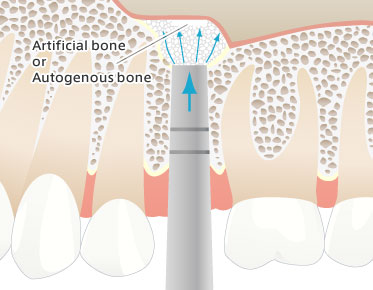"Dental Implants Net" is an information site aimed at providing a better public understanding and popularization of dental implants.
Differences between sinus lift and socket lift
Reason to perform sinus lift or socket lift
The sinus lift technique is used in cases in which the height of the upper jaw is insufficient.
The maxillary sinus (paranasal sinus) is a hollow portion in the upper jawbone above the back teeth region, i.e., next to the nose and beneath the eyes.
The bone thickness at the sinus may be insufficient for implant placement for a number of reasons, including long-term tooth loss and bone loss due to gum disease. In such cases, placement of an implant may push up into the maxillary sinus due to the lack of bone.
Moreover, if an excessive load is imposed on the implant, it may fall into the maxillary sinus.
Thus, the bone is inserted into the maxillary sinus to maintain the sufficient bone thickness with the sinus lift or socket lift technique .
Differences between sinus lift and socket lift
Sinus lift

Procedures for sinus lift
- The sinus lift technique approaches from alveolar lateral side to the maxillary sinus
- The sinus lift technique is used in cases in which the thickness of the upper jaw is less than 5 mm or multiple tooth lost.
The lateral side of the upper gum is incised to expose the bone surface and form a window of about 10 – 30 mm2 in the alveolar bone.
The window is opened to expose the Schneiderian membrane (maxillary sinus mucosa), and then the alveolar bone and Schneiderian membrane are carefully exfoliated to pack grafting bone. Bone is formed over the following 3 – 6 months. Thereafter, as an implant is placed, the treatment takes about 9 months.
Socket lift

Procedures for socket lift
- The socket lift technique approaches from the alveolar crest or the extraction cavity to the maxillary sinus.
- The socket lift technique is applicable in cases where the bone height to the Schneiderian membrane is greater than 5 mm.
- The socket lift technique can have a shorter treatment period and less pain/swelling due to the smaller wound compared with the sinus lift technique.
The cavity (space after tooth extraction) is gradually filled with grafted bone to push up the Schneiderian membrane to obtain sufficient bone thickness for implant placement. Following implant placement, it takes about 4 months before it is possible to chew normally.

- What type of dental treatment do you require?
- Basic knowledge of dental implants
- Dental Implants surgery
- Before&After - Photos of dental implant cases
- Success stories
- FAQ
- Privacypolicy
- About us
- sitemap
- Dental Glossary
- Find an Implant Dentist
- To dentists and managers











